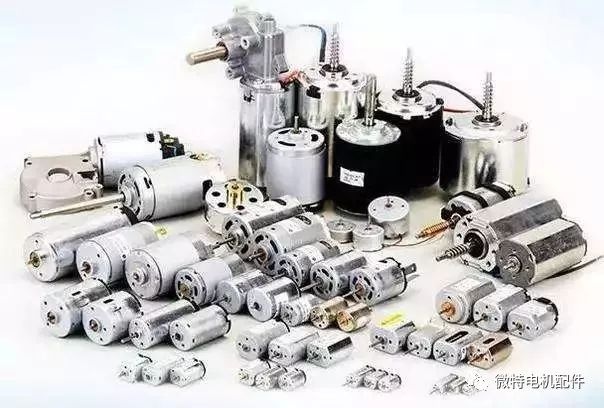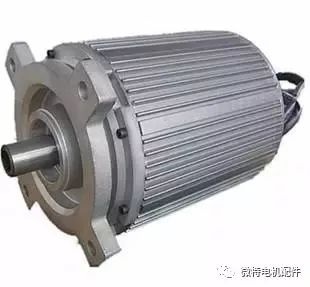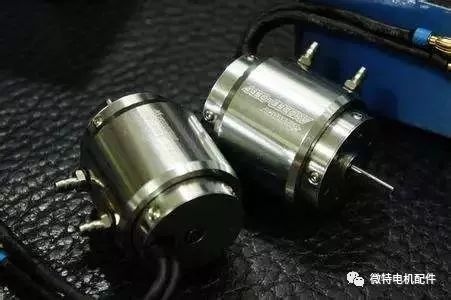![]()
Nowadays, in practical applications, micro-motors have been developed from simple starting control and power supply to precise control of their speed, position, torque, etc., especially in industrial automation, office automation and home automation. Almost all of them use mechatronics products that combine motor technology, microelectronic technology and power electronics technology. Electronization is an inevitable trend in the development of micro-motors.
Modern micro-motor technology integrates a number of high-tech technologies such as motors, computers, control theory, and new materials, and is moving from military and industrial to daily life. Therefore, the development of micro and special motor technology should be adapted to the development needs of pillar industries and high-tech industries. Micro motors are mainly used in the following aspects:
1. Application fields of micro motors
1-1: Micro motor for home appliancesIn order to continuously meet the requirements of users and adapt to the needs of the information age, to achieve energy saving, comfort, networking, intelligence, and even network appliances (information appliances), the replacement cycle of household appliances is very fast, and high requirements are put forward for their matching motors. Efficiency, low noise, low vibration, low price, adjustable speed and intelligent requirements. Micro-motors for household appliances account for 8% of the total micro-motors: including air conditioners, washing machines, refrigerators, microwave ovens, electric fans, vacuum cleaners, dewatering machines, etc. The annual demand in the world is 450 million to 500 million units (sets), and the power of such motors is not large, but there are many kinds. The development trend of micro and special motors for home appliances is as follows:① Permanent magnet brushless motor will gradually replace single-phase asynchronous motor;② Optimize the design and improve the quality and efficiency of the product;③ Adopt new structure and new technology to improve production efficiency.1-2: Micro motor for information processing equipmentMicromotors for information processing equipment accounted for 29%: including information input, storage, processing, output, conduction and other links, including communication equipment. The world needs 1.5 billion units (sets) every year, mainly including permanent magnet DC motors, brushless DC motors, stepping motors, and micro synchronous motors. The annual output of microcomputer (PC) was about 100 million in 2000, and it is estimated to be 200 million in 2005. The demand for micro-motors for its key components is large and the requirements are getting higher and higher. Most of these motors are precision permanent magnet brushless motors and precision stepper motors.

Their characteristics and development directions are:(1) High investment productsThis type of motor has very high requirements on the stability of the speed and the runout of the rotating shaft, so this type of motor is a high-tech, high-investment product that combines advanced manufacturing technology and emerging power electronics technology. Production.(2) Miniaturization and sheetingIn order to meet the needs of miniaturization and carrying of information products, the requirements of miniaturization and flakes are put forward for its supporting motors.With the continuous improvement of the storage density of computer peripherals, it is required that the motor speed should be above 8000r/min.1-3: Micro motor for automobileAutomotive micro-motors account for 13%, including starter generators, wiper motors, motors for air conditioners and cooling fans, electric speedometer motors, window-swing motors, and door-lock motors. In 2000, the world's automobile production was about 54 million, and each automobile required 15 motors on average, and the global demand was 810 million.The development focus of automotive micro-motor technology is as follows:(1) High efficiency, high output, energy savingThrough high-speed, high-performance magnetic material selection, high-efficiency cooling means and improving the efficiency of the controller, its operating efficiency is improved.Intelligentize the motor and controller of the car, so that the car runs in the best state and the energy consumption is minimized.1-4: Micro motor for audio equipmentMicro-motors for audio equipment accounted for 18%, including record players, tape recorders, VCD video discs and DVD video discs. The annual demand in the world is more than 1 billion units (sets). At present, domestic production has accounted for about 60%, mainly including printed winding motors and winding disc motors.1-5: Micro motor for video equipmentVideo equipment with micro-motors accounted for 7%, including video cameras, cameras and so on. The annual demand in the world is 350 million to 400 million units (sets). This type of motor is a precision type, and it is difficult to manufacture and process. Especially after entering the digitalization, more stringent requirements are put forward for the motor.1-6: Micro motor for industrial electrical drive and controlSuch micro-motors account for 2%, including CNC machine tools, manipulators, robots, etc. Mainly for AC servo motor, power stepper motor, wide speed DC motor, AC brushless motor and so on. This type of motor has many varieties and high technical requirements. It is a type of motor with a rapid increase in domestic demand.1-7: Special purpose micro motorSuch motors account for about 23%, including aerospace flight, various aircraft, automated weapons and equipment, and medical equipment. Such motors are mostly special motors or new-type motors, including motors that are different from general electromagnetic principles in principle, structure and operation mode, mainly low-speed synchronous motors, harmonic motors, finite-angle motors, ultrasonic motors, and microwave motors. , capacitive motors, electrostatic motors, etc. Among them, ultrasonic motor, microwave motor, capacitive motor and electrostatic motor are special motors which are different from general motors in principle, structure and operation. The appearance and development of these motors are closely related to the development of electronic technology and control technology.
2. New product technology of micro motor
With the continuous advancement of science and technology and the continuous introduction of new requirements in practical applications, there have been a variety of micro-motors that are different from traditional electromagnetic motors. They employ novel design concepts, methods, structures and principles.2-1: Permanent magnet brushless motorBrushless motors are the development direction of micro motors and have been applied in the fields of information, home appliances, audio and video, and transportation. With the rapid development of permanent magnet materials and power electronics technology, the continuous improvement of performance and the continuous reduction of prices, the brushless motor will be further developed, and the demand will become larger and larger. Compared with the general asynchronous motor, the new brushless motor The power consumption is reduced by 30% to 35%, which meets the requirements of high efficiency, energy saving, small size and light weight. Although the cost and price of brushless motors are higher than that of asynchronous motors, due to their low power consumption, high efficiency, and reduced operating costs, from the point of view of energy saving, the popularization of brushless motors is bound to be the general trend. The world's major companies have launched fierce competition in the field of brushless motors. Therefore, with the improvement of the performance of components and materials, the performance of the brushless motor will also be greatly improved, and the speed competition of technology development will be more prominent.

Ultrasonic motor (USM for short) uses the inverse piezoelectric effect of piezoelectric materials to make the elastic body (stator) produce microscopic mechanical vibration (the vibration frequency is above 20 kHz) in the ultrasonic frequency band, through the connection between the stator and the rotor (or mover). The friction between the stators converts the microscopic vibration of the stator into the macroscopic unidirectional rotation (or linear motion) of the rotor (or mover). It breaks the concept of traditional motor that obtains speed and torque by electromagnetic effect, and it is also a new technology that attracts attention in the development of micro-motor technology.

Compared with traditional motors, ultrasonic motors have a series of advantages:(1) The structure is simple, it consists of two basic parts: vibration parts and moving parts;(2) The torque per unit volume is large, which is 10 times that of the traditional motor of the same volume;(3) Good low-speed performance, the speed can be adjusted to zero, and large torque can be directly output at low speed;(4) The braking torque is large and no additional brake is required;(5) Small mechanical time constant and good fast performance;(6) There is no magnetic field and electric field, no electromagnetic interference and electromagnetic noise, etc.At present, ultrasonic motors have been commercialized by many companies in foreign countries such as Japan. Canon, Panasonic, Hitachi and other new ultrasonic motor products have been used in advanced cameras, video cameras, optical instruments. The development direction of ultrasonic motor technology is to further improve efficiency.The ultrasonic motor adopts a brand-new principle and structure, and does not need magnets and coils, but directly obtains motion and force (moment) by using the inverse piezoelectric effect of piezoelectric materials and ultrasonic vibration. It breaks the concept of motor that obtains speed and torque by electromagnetic effect so far, and it is a high-tech at the forefront of current world science. Due to ultrasound, the motor has many characteristics that the electromagnetic motor does not have. Although its invention and development is only 20 years old, it has been successfully applied in the fields of aerospace, robotics, automobiles, precision positioning, medical equipment, and micro-machines. .2-3: High-speed dynamic pressure bearing motorWith the development of information products in the direction of high efficiency, high density and micro, light and thin, the speed of the precision permanent magnet brushless motor matched with them is as high as 8000~50000r/min. The bearings of high-speed motors will also replace traditional sliding bearings with dynamic pressure bearings to overcome many technical problems caused by high speed.Compared with ball and sliding bearings, dynamic pressure bearings have many advantages; they can suppress irregular shaft swing, improve impact resistance, long life, and low noise. There are two types of dynamic pressure bearing motors, fluid and air. Generally, the fluid dynamic pressure bearing is used for low speed, and the air dynamic pressure bearing is used for high speed. Although there are still some technical problems to be solved in the dynamic pressure bearing motor, it has been generally confirmed that the high-speed dynamic pressure bearing motor is the development direction.With the rapid development of automatic control technology, the requirements for the positioning accuracy of various automatic control systems are getting higher and higher. The traditional rotary motor plus a set of transformation mechanisms to form a linear motion device can no longer meet the accuracy requirements. One of the contents of modern servo drive technology research, linear motor is the key technology. The application field of linear motor is also extensive. In the device that needs linear motion, the linear motor with direct drive will be better than the rotary motor. Since the motion conversion mechanism is omitted, the control precision can be improved.Ultra-micro motor technology is a new high-tech field using micro-electromechanical system technology (MEMS) developed in the past 20 years. A device with energy conversion and transmission functions. The emergence of MEMS technology has brought a revolutionary leap to the traditional mechanical manufacturing technology. Ultra-micro motors have electrostatic principle ultra-micro motors and electromagnetic ultra-micro motors. Because electromagnetic ultra-micro motors have larger torque than electrostatic ultra-micro motors, high conversion efficiency and long life, it has been used in many fields such as endoscopy, micro-robots. etc. to be applied. Now, the United States, Japan, Russia, Germany, etc. have invested a lot of manpower, material and financial resources to carry out the research and application of this technology, and have made great progress, some of which are practical. For example, Toshiba Corporation of Japan has developed the world's smallest ultra-micro motor with a weight of 40 mg, a speed of 60-1000 r/min, a voltage of 1.7 V, and a diameter of only 0.8 mm. electric motor. It can be expected that with the development and application of nano-manufacturing technology, ultra-micro motors will also be greatly developed, so that it has more application fields.With the development of MEMS, na2noelectromechanicalsystems (NEMS) have appeared, and the feature size may be from several hundreds to several nanometers, some of which have important potential applications in the field of biomedicine. Ricky K. Soong of Cornell University in the United States integrated a single biomolecular motor and a nanoscale inorganic system to form a hybrid nanomechanical device driven by a molecular motor. This biomolecule (less than 8nm in diameter, 14nm in length) motor can generate a maximum torque of 80-100pN·nm by hydrolyzing ATP (adenosine triphosphate) in an active system, which is comparable to the size of currently produced nanomechanical structures. Compatible with mechanical constants. This new technology is expected to play a role in vascular debridement.
3. Development trend of micro and special motors
After entering the 21st century, the sustainable development of the world economy is faced with two key issues—energy and environmental protection. Special motors are not only widely used in industrial and mining enterprises, but also in commercial and service industries, especially when more products enter the family life, so the safety of motors directly endangers personal and property safety; motor vibration, noise, Electromagnetic interference will become a public nuisance to pollute the environment; the efficiency of the motor is directly related to energy consumption and harmful gas emissions, so the international requirements for these technical indicators are becoming more and more strict, which has attracted the attention of the motor industry at home and abroad. Technology, materials, electronic components, control circuits and electromagnetic design have carried out energy-saving research. On the basis of excellent technical performance, the new round of micro-motor products will take energy-saving and environmental protection as the purpose, and implement relevant regulations. International standards to promote related technological progress, such as new motor punching, winding design, ventilation structure improvement and low-loss and high-permeability materials, rare earth permanent magnet materials, noise reduction and vibration reduction technology, power electronics technology, control technology, and electromagnetic interference reduction technology and other applied research.
Under the premise that the trend of economic globalization is accelerating, countries pay more attention to the two major issues of energy saving and environmental protection, international technical exchanges and cooperation are strengthened, and the pace of technological innovation is accelerated, the development trend of micro-motor technology is:(1) Adopt high-tech and develop towards electronic direction;(2) High efficiency, energy saving and green development;(3) Development towards high reliability and electromagnetic compatibility;(4) To develop towards low noise, low vibration, low cost and price;(5) To develop towards specialization, diversification and intelligence.In addition, micro and special motors are developing in the direction of modularization, combination, and intelligent electromechanical integration, as well as in the direction of brushless, ironless, and permanent magnetization. It is particularly noteworthy that with the expansion of the application field of micro and special motors, environmental changes Changes, the traditional electromagnetic principle motor can not fully meet the requirements. Using the new achievements of related disciplines, including new principles and new materials, to develop micro-motors with non-electromagnetic principles has become an important direction of motor development.
4. Development Suggestions
Although the research of microcomputers in domestic relevant units and research institutes has made great progress in recent years, compared with foreign countries, there is still a gap. In the face of fierce international competition, we can only be invincible in the international competition in this field by strengthening research and cooperation, giving full play to our innovation capabilities, and narrowing the gap with foreign micro-motors. Efforts to:(1) Due to the serious lack of funding for many units engaged in micro-motor technology research, the research force (manpower, equipment) is very thin, and the basic research conditions cannot be guaranteed. It is suggested that the relevant departments will greatly increase the investment in the research and development of micro-motor technology in the near future.(2) It is suggested that relevant departments quickly organize specialized research units to study related micro-motor materials, such as piezoelectric ceramics, friction materials, rare earth materials, permanent magnet materials, etc., and further strengthen exchanges and cooperation between research units and production enterprises.(3) Strengthen the communication and communication between the research units, concentrate and avoid duplication of work.(4) At present, the research results of some universities and research institutes cannot be transformed into productive forces; it is necessary to form an industrialization base for micro-motors that integrates production, learning and research.(5) Actively carry out research on long-life, high-reliability design and advanced manufacturing technology of micro-motors.(6) On the basis of in-depth research on the theory, manufacturing technology and materials of micro-motors, a large number of experimental studies are carried out, including: various performance tests, life tests, reliability tests and environmental (high temperature, low temperature, humidity and vacuum) test, etc.(7) Develop new micro-motor technology, including new motor motion mechanism, new mode conversion method, and development of ultra-micro motor, linear motor and non-contact motor, etc.






























 XINDA
XINDA